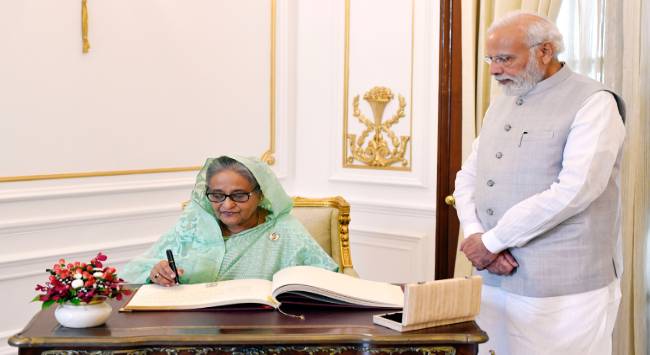Prime Minister Sheikh Hasina’s Visit to India –
Towards Sustainable Bilateral Cooperation
Divya Murali, Mohammad Masudur Rahman
15 September 2022Summary
Bangladesh’s Prime Minister Sheikh Hasina’s visit to India in early September 2022 aims to strengthens bilateral cooperation through greater connectivity, trade facilitation and mutual interest for regional peace and stability. Her visit also signals to Indian Prime Minister Narendra Modi that a stable neighbour is vital to realise shared benefits and prosperity bilaterally as well as regionally.
Bangladeshi Prime Minister Sheikh Hasina went on a state visit to India from 5 to 8 September 2022 on the invitation from India’s Prime Minister Narendra Modi. A range of issues on bilateral cooperation was discussed, and seven agreements were signed between the two countries, including water management, scientific and space technology cooperation, media, railway infrastructure and capacity building. A power project, financed by India to help Bangladesh’s power crisis and road and rail connectivity projects, was also unveiled. Both countries also agreed to begin negotiations on the Comprehensive Economic Cooperation Agreement (CEPA) in 2022 and have it concluded by 2026 to ensure continued free market access for Bangladesh as it graduates from the status of a Least Developed Country (LDC).
India and Bangladesh have shared close historical ties. In recent years, there has been a constant stream of high-level engagements and negotiations between the neighbours that share a 4,000 kilometres-long border and 54 common rivers. This was acknowledged in the joint statement released by both countries during the latest state visit. The seven agreements signed and the initiatives unveiled during the visit resulted from this continuous engagement aimed at strengthening bilateral and sub-regional cooperation.
Some of the key specific outcomes from the visit included a) the agreement for closer border and security cooperation; b) expanding bilateral development cooperation via capacity building in roads and railways; c) exploring innovative financing for developmental projects; d) commitment to build resilient supply chains between the two countries and also for the region; e) focussing on expanding connectivity through infrastructure – road, railways, and waterways – as well as improving people to people ties; and f) integrating energy and power infrastructure logistics to not only support bilateral demands but also for larger sub-regional benefits.
Besides these, bilateral trade between India and Bangladesh is set to get a boost as the countries agreed to launch negotiations for the CEPA. During a period when Bangladesh is set to face challenges in free market access owing to the country’s pending LDC graduation, the CEPA will be crucial in addressing these challenges by allowing free access to a large immediate market for Bangladesh. Bilateral trade between the two countries has been growing steadily, owing to concerted diplomatic efforts and the constant stream of projects that have improved road, rail and waterways connectivity. With the CEPA, reports on the joint feasibility study done by India and Bangladesh indicated that the total bilateral gains by trade in goods would range from US$7 billion (S$9.84 billion) to US$15 billion (S$21.09 billion).
Focussed measures committed toward improving trade facilitation and infrastructure, along with the CEPA, will generate greater benefits. A World Bank working paper shows that while Bangladesh’s exports could rise 182 per cent with a free trade agreement, this could become 300 per cent if combined with trade facilitation measures and reduced transaction costs. Besides increasing bilateral trade and investments, the CEPA could also indirectly help propel sub-regional trade, especially in the light of many connectivity projects undertaken to boost the integration of north-eastern India towards the Bangladesh, Bhutan, India, Nepal Initiative and the Bay of Bengal Initiative for Multi-Sectoral Technical and Economic Cooperation.
While there are still issues that remain unresolved in the larger realm like the water management of the Teesta River and the Rohingya refugee displacement in the aftermath of the pandemic and other global developments, the prevailing impetus for cooperation seems to be relatively more rooted in the strategic and economic partnerships and connectivity towards enabling resilient supply chains. India and Bangladesh have recognised how critical this is for their bilateral ties and the sub-region as a whole as well.
Finally, while Bangladesh is in the middle of tackling a host of economic issues, the country is also due to face a general national election in 2023. The last two elections held in 2014 and 2018 under the current ruling party were not credible and inclusive. The national elections next year will be important for Bangladesh’s growth and stability. Hasina’s government has signalled to India that a stable neighbour is vital to realise shared benefits and prosperities bilaterally and regionally.
. . . . .
Ms Divya Murali is a Research Analyst at the Institute of South Asian Studies (ISAS), an autonomous research institute at the National University of Singapore (NUS). She can be contacted at divya.m@nus.edu.sg. Dr Mohammad Masudur Rahman is a Visiting Research Fellow at the same institute. He can be contacted at masudrahman@nus.edu.sg. The authors bear full responsibility for the facts cited and opinions expressed in this paper.
Pic Credit: Narendra Modi’s Twitter Account
-
 More From :
More From :
-
 Tags :
Tags :
-
 Download PDF
Download PDF


